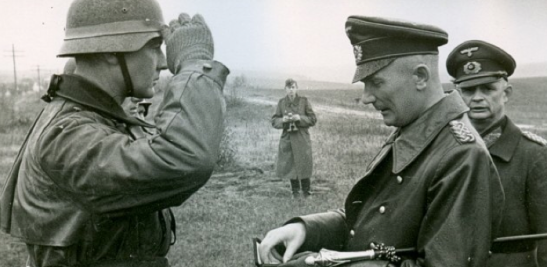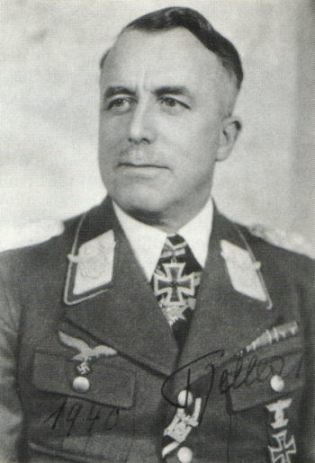[English version at the end]
PROTAGONISTAS DE BARBARROJA
¡Ya a la venta Barbarroja 03:00 hrs!
TENIENTE GENERAL ERICH HÖPNER (1886 – 1944)

Der alte Reiter (el Viejo Caballero) como se le llega a conocer, comienza su carrera operativa en la Primera Guerra Mundial como oficial de estado mayor del 16º Cuerpo de Ejército. En el periodo de entreguerras será uno de los pocos en integrar el Reichswehr en una sección del Ministerio de la Guerra de inspección de caballería. En abril de 1939 será promovido al empleo de general de caballería (General der Kavallerie) y destinado al 16º Cuerpo Motorizado.
Al comenzar la Segunda Guerra Mundial participa en la campaña polaca y francesa, concluida la cual será ascendido a teniente general (Generaloberst), habiendo ocupado el puesto de jefe del estado mayor del mariscal de campo Rundstedt.
Desde febrero de 1941 ostenta el mando del 4. Panzergruppe, el cual para el inicio de la campaña de invasión de la URSS, Operación Barbarroja, será asignado bajo dependencia operativa del Grupo de Ejércitos Norte del Mariscal von Leeb. Su misión: la captura de Leningrado a través de las antiguas repúblicas bálticas. Sus fuerzas consisten en:
XLI. Armeekorps (mot.)> Reinhardt
-1. Panzer Division
-6. Panzer Division
-36. Infanterie Division (mot.)
-269. Infanterie Division
LVI. Armeekorps (mot.)>Manstein
-8. Panzer Division
-3. Infanterie Division (mot.)
-290. Infanterie Division
(Reservas: Waffen-SS Motorisierte Division «Totenkopf»)

Su progresión a través de las ex-repúblicas bálticas, Lituania, Letonia y Estonia, ahora todas ellas territorio de la URSS desde su ocupación militar en el invierno 1939-40 (en virtud de las cláusulas secretas del Pacto de No-Agresión Hitler-Stalin), no va a estar exenta de serias reacciones del Frente Noroccidental (Kuznetsov). Sus Panzer serán la punta de lanza encargada de tomar los pasos sobre el río Dvina Occidental a toda velocidad, penetrando a través de 3 ejércitos del adversario (8º, 11º y 27º). No pierde de vista que su objetivo final (Directiva nº 21 del Führer) es Leningrado y Arkhangelsk. Este último enclave constituye la última y deseada línea geográfica (Arkhangelsk-río Volga) de ocupación en territorio ruso.
En tiempo récord captura los puentes sobre el río Niemen, con tanta presteza que aún están intactos y sin respiro y sin cuidarse de la protección de sus flancos, sigue hacia adelante. Pero no va a ser un paseo militar. La primera crisis la va a tener que sortear en la región de Raiseniai, hacia donde Kuznetsov pretende enviar una tenaza acorazada para estrangular el avance de los Panzer. Así pues su 6ª División Panzer recibe la embestida de la 2ª División Acorazada del RKKA, cuando los primeros intentan sortear el río Dubissa y se ven obligados a replegarse en circunstancias muy adversas hacia Raiseniai. Es aquí donde se encuentran por primera vez con un modelo de carro de combate secreto: el Kliment-Vosroshilov, una máquina de 52 toneladas contra la que los blindados y la artillería contracarro germana son impotentes.

Resuelta la crisis en Raiseniai, no sin pérdidas importantes, alcanza fulgurante el curso del Dvina Occidental y se establece en dos cabezas de puente (Jekavpils y Daugavpils). La primera etapa de su misión está cumplida. El general Lelyushenko intenta en vano destruir esas cabezas de puente, pero los germanos han sido demasiado rápidos antes de que el soviético haya tenido tiempo de consolidarse tras las aguas del Dvina.
Los riesgos siguen presentes, ya que el RKKA se las arregla para lanzar nuevas unidades a la batalla. Ya en la región del este del lago Pskov (sector de Soltsy), su 8ª División Panzer avanza tan velozmente y en solitario, que esta vez el Ejército Rojo consigue coparla. Su jefe, Brandenburger, tendrá que dar media vuelta y forzar una retirada desesperada con grandes pérdidas. Milagrosamente se salva de la aniquilación completa gracias a la intervención, entre otras unidades, de la Waffen SS Motorisierte Division “Totenkopf”. Tras la batalla la 8ª de Panzer quedará en retaguardia.
Höpner fuerza la línea del Luga (este del lago Pskov) y última línea defensiva del General Popov (Frente Norte). Es el 14 de julio de 1941 cuando Reinhardt, jefe del XLI Cuerpo de Ejército (motorizado), se establece a sangre y fuego en una cabeza de puente, pero de repente llegan órdenes de un parón operativo. Leningrado parece tan cercano, que sus comandantes se exasperan aguardando y viendo impotentes pasar la oportunidad que se les podría brindar. Reinhardt se desespera contando cómo los días pasan sin recibir órdenes de reanudar el asalto (la luz verde llegará el 8 de agosto). Finalmente llegará a las puertas de Leningrado. Pero Hitler no autorizará la toma de la gran urbe. El 6 de septiembre de 1941, el Führer del III. Reich emite la instrucción número 35 (Weisung nummer 35) para detener la ofensiva a gran escala sobre Leningrado del Grupo de Ejércitos Norte y asignar los Panzer de Höpner al Grupo de Ejércitos Centro como refuerzo para la ofensiva sobre Moscú. No obstante von Leeb contará con un número importante medios blindados hasta la mitad de septiembre. Leningrado será sometida a asedio…Durará 900 días…
En diciembre de 1941, en el momento cumbre de la batalla de Moscú, incumplirá las órdenes del Führer de resistir en las posiciones a toda costa e iniciará por su cuenta una retirada. Caerá en desgracia. El 8 de enero de 1942 será relevado del mando de su Panzergruppe. Involucrado en la trama de intento de asesinato de Hitler del 20 de julio de 1944, será arrestado, juzgado y condenado a morir en la horca.
¿Te ha resultado de interés este artículo? ¿Querrías conocer los detalles de esta y las demás operaciones?
¡Adquiere la obra cronológica Barbarroja 03:00h en edición de coleccionista!
Deja tu comentario abajo y sigue CONQUISTAR RUSIA punteando en la opción «SEGUIR / FOLLOW» a la izquierda de la página
[English version]
BARBAROSSA’S PROTAGONISTS
COLONEL-GENERAL ERICH HÖPNER (1886 – 1944)

As known as «Der alte Reiter» (the Old Knight) Colonel-General Erich Höpner starts his operational career during World War I as a staff officer in the 16th Army Corps. In the inter-war period he will be one of the few to belong to the Reichswehr in the Cavalry Inspection, a part of the Ministry of War. In April, 1939 he will be promoted to Cavarly General (General der Kavallerie) and assigned to the 16th Motorized Corps. At the start of World War II Höpner will participate in the Polish campaign (1939) and in the French one (1940). Once both victoriously concluded he will become Colonel-General (Generaloberst) having occupied the job of Chief-of-Staff in Field Marshall von Rundstedt‘s headquarters.
Since February, 1941 he is in command of the 4. Panzergruppe, part of Field Marshall von Leeb’s Army Group North at the start of Operation Barbarossa. His mission: the capture of the historical city of Leningrad (today Saint Petersburg) through the old Baltic Republics. He counts on the follwing forces:
XLI. Armeekorps (mot.)> Reinhardt
-1. Panzer Division
-6. Panzer Division
-36. Infanterie Division (mot.)
-269. Infanterie Division
LVI. Armeekorps (mot.)>Manstein
-8. Panzer Division
-3. Infanterie Division (mot.)
-290. Infanterie Division
(Reserves: Waffen-SS Motorisierte Division «Totenkopf»)

His advance through the ex-Baltic Republics, Lithuania, Latvia and Estonia, now USSR territory after its military occupation in the winter, 1939-40 (by virtue of the Non-Aggression Pact‘s secret protocols, agreed between Hitler and Stalin), Höpner will face several serious Soviet counterattacks from Kuznetsov’s Northwestern Front. The German is the armoured spearhead in charge of taking bridgeheads over the Western Dvina river at full speed. He will make his way across 3 Soviet armies (8th, 11th and 27th). Höpner has in mind his final objectives as per the Führer’s Directive no. 21, Leningrad and Arkhangelsk. The latter is the final and desired geographical line (Arkhangelsk-Volga river) to be secured in «Mother Russia».
He swiftly captures the still intact bridges over the Niemen river and without respite and no major concerns about his exposed flanks, continues racing forward. But things won’t be then as easy. Der alte Reiter will sort out his first crisis in the area of Raiseniai, where Kuznetsov pretends to pincer Höpner in order to strangle his advance. His 6th Panzer Division will endure the assault of the RKKA’s 2nd Armoured, when the former attempts to cross the Dubissa river. The situation becomes immediately critical as they are forced back again towards Raiseniai. Here Höpner‘s men fight off a new secret tank model: The Kliment-Voroshilov type, a 52-ton juggernaut. None of his Panzer and antitank cannons have any chance against them.
Once sorted out at Raiseniai with severe losses, he will capture two bridgeheads over the Western Dvina river (Jaukavpils and Daugavpils). The first stage of his mission is accomplished. RKKA General Lelyushenko tries to destroy these bridgeheads but to no avail, as the Germans have been too fast. Leluyshenko has simply have no time to consolidate his defenses behind the waters of the large river.


Nevertheless the risks for the advancing Colonel-General are still looming because the RKKA manages to throw into the fray new fresh units out of the reserves. Due east of lake Pskov (Soltsy sector), his 8th Panzer Division advances too quickly and alone that this time the Red Army manages to encircle it. Under Branderberger’s command, the division of tanks will force his way back to its own lines with high losses (miraculously without being fully annihilated), thanks to the help, amongst others, of the Waffen SS Motorisierte Division “Totenkopf”. After the desperate encirclement battle the Panzer unit will remain in the rearguard for rest and refit.

However Höpner will pass the Luga line, the last defensive line of General Popov (Northern Front). It is actually his Commander of the 41st Motorized Army Corps, Reinhardt, who furiously establishes himself on bridgeheads over the Luga river. But suddenly new orders arrive for an operational halt. It is the 14th of July, 1941. Reinhardt desperately counts the passing days losing his opportunity to enter in the historical enclave (the «green light» will come on the 8th of August). Höpner‘s Panzer commanders enrage already seeing Leningrad at the reach of their hands. Eventually they will advance up to the gates of Leningrad when the offensive is reassumed. But then Hitler orders a stop in order to besiege the city. The city cradle of Bolshevism will not be assaulted, but razed. On the 6 of September, 1941 Hitler issues his instruction (Weisung nr. 35) to stop the full-scale advance of Army Group North onto Leningrad and to send Höpner‘s 4th Panzer Corps to strengthen Army Group Center‘s offensive on Moscow. Nevertheless, many of the Corps’ tanks will remain at Leeb’s disposal up to the second half of September. Thus Leningrad becomes under siege. …it will last 900 days…
In December, 1941, during the apex of the Battle for Moscow, Colonel-General Höpner will ignore Hitler‘s orders to stand fast ordering a retreat in desperate circumstances. He will fall in disgrace. On the 8th of January, 1942 he is relieved from Command. Under charges of having participated in the assassination attempt of Hitler on the 20th of July, 1944, he will be arrested and tried. History will spare for him a tragic fate.
Did you find this article interesting? Leave your comments below and follow us clicking on «SEGUIR / FOLLOW» at the left of the page







































